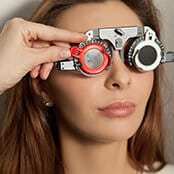Optical Coherence Tomography (OCT) - Eye Imaging Test
Introduction
Optical Coherence Tomography (OCT) is a new type of imaging technology. OCT is used for taking cross-sectional pictures of the retina. The retina is located at the back of your eye. It is used to diagnose and follow treatment in certain eye conditions and diseases, such as age-related macular degeneration, diabetic retinopathy and other diseases affecting the macula.
Anatomy
The retina is located at the back of your eye. The retina is a thin tissue layer that contains millions of nerve cells. The nerve cells are sensitive to light. A main purpose of your eye is to focus light on the retina. The choroid is the lining underneath the retina. The choroid contains blood vessels that supply your retina with blood and oxygen to keep it healthy.
Uses
OCT is a non-invasive imaging test. OCT is a unique test because it allows doctors to look at cross-sectional layers of the retina. Each of the ten layers in the retina can be detected. OCT allows a doctor to measure the thickness of each layer to aid in the early detection and diagnosis of retinal diseases and conditions. Such conditions include age-related macular degeneration, pre-retinal membranes, macular swelling, macular holes, cystoid macular edema, central serous retinopathy, glaucoma, and optic nerve damage.
Preparation
There is no special preparation for this test.
Testing
The testing time is very short. You will be seated for the test. Your face will be stabilized with a positioning device during the test. Your doctor will use a special camera to take pictures of your inner eye. The images are transmitted to a computer for your doctor to view.

Copyright © - iHealthSpot Interactive - www.iHealthSpot.com
This information is intended for educational and informational purposes only. It should not be used in place of an individual consultation or examination or replace the advice of your health care professional and should not be relied upon to determine diagnosis or course of treatment.
The iHealthSpot patient education library was written collaboratively by the iHealthSpot editorial team which includes Senior Medical Authors Dr. Mary Car-Blanchard, OTD/OTR/L and Valerie K. Clark, and the following editorial advisors: Steve Meadows, MD, Ernie F. Soto, DDS, Ronald J. Glatzer, MD, Jonathan Rosenberg, MD, Christopher M. Nolte, MD, David Applebaum, MD, Jonathan M. Tarrash, MD, and Paula Soto, RN/BSN. This content complies with the HONcode standard for trustworthy health information. The library commenced development on September 1, 2005 with the latest update/addition on February 16, 2022. For information on iHealthSpot’s other services including medical website design, visit www.iHealthSpot.com.




